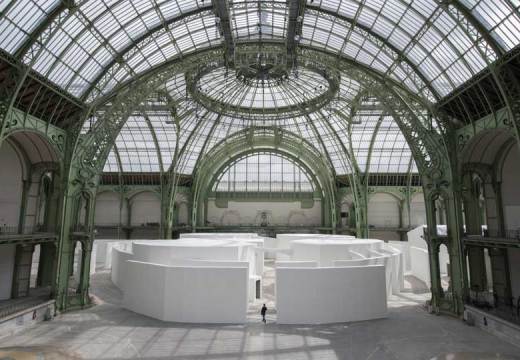A balcony running inside a converted Victorian swimming baths is an odd place to find oneself enjoying a trilogy of arias performed live by a soprano from Scottish Opera. But when the swimming baths are those that now house the looms of Edinburgh’s illustrious tapestry workshop, Dovecot Studios, it is perhaps less unlikely.
Once described by John Bellany as ‘the most creative place in Scotland’, Dovecot is a place where anything might happen. On Monday, the drama came not only from the astonishing power of Catrin Aur’s singing, the physical force of which could be felt in every corner of this glorious space, but also from events unfolding, quite literally, on the weaving floor below the balcony.
A ‘cutting off ceremony’, as this was, marks the moment when a tapestry is finally released from the loom. There is something umbilical in the symbolism here; the infant tapestry being severed from its parent to begin an independent life. It is not the mother figure, the weaver, who does the cutting though – this is taboo, a surprising superstition amongst the weaving community.

Alison Watt, cutting the ‘Butterfly’ tapestry from the loom. Dovecot Studios, 19 May 2014. Courtesy of Dovecot Studios
The first snipper of the warps that hold the tapestry vertical upon the loom was the painter Alison Watt, whose design formed the basis of this piece. Her duties were shared by Alastair and Elizabeth Salvesen, Trustees of Dovecot Foundation, Ian Robertson, Chair of the Theatre Royal Board and Colin McClatchie, Chair of the Scottish Opera Board. The tapestry is to be hung in the redesigned Theatre Royal in Glasgow, home of Scottish Opera, who commissioned the work. Spontaneous cheers were provoked by the severing of the final warp.
The tapestry is a gigantic affair, the second largest ever created at Dovecot, and, laid out on the floor, it dwarfs the original painting, which stands beside it. Seeing the two together, it is clear how the process is far more than the mere copying of an image. Rather, it is a reinterpretation, or translation, and here lies the skill of Naomi Robertson and her team of weavers. The hues of the final piece are richer, the contrasts deeper and the fall of light across the textured surface produces an almost iridescent effect that many of the assembled guests remarked upon.

Alison Watt, Butterfly tapestry cut from the loom. Dovecot Studios, 19 May 2014. Courtesy of Dovecot Studios
The design represents a section of patterned cloth which, despite the flat weave of the tapestry, looks deeply folded. There is a definite nod to Madame Butterfly, the company’s first opera, in the oriental design while the deep chasm that cuts diagonally across the image and beckons the viewer in will be recognisable to anyone familiar with Watt’s fabric paintings.
The cutting off ceremony is an artistic drama like no other. The tapestry, which coils around the loom as it is woven, has never been seen before in its entirety, and there is a genuine sense of anticipation. The artist and weavers begin the event as tense as the warps and then relax in unison with the tapestry as it is revealed, intact, entire and beautiful.
Related Articles:
Weaving the colours of music (Claudia Massie for The Spectator)
Unlimited access from just $16 every 3 months
Subscribe to get unlimited and exclusive access to the top art stories, interviews and exhibition reviews.














![Masterpiece [Re]discovery 2022. Photo: Ben Fisher Photography, courtesy of Masterpiece London](http://www.apollo-magazine.com/wp-content/uploads/2022/07/MPL2022_4263.jpg)
It’s time for the government of London to return to its rightful home